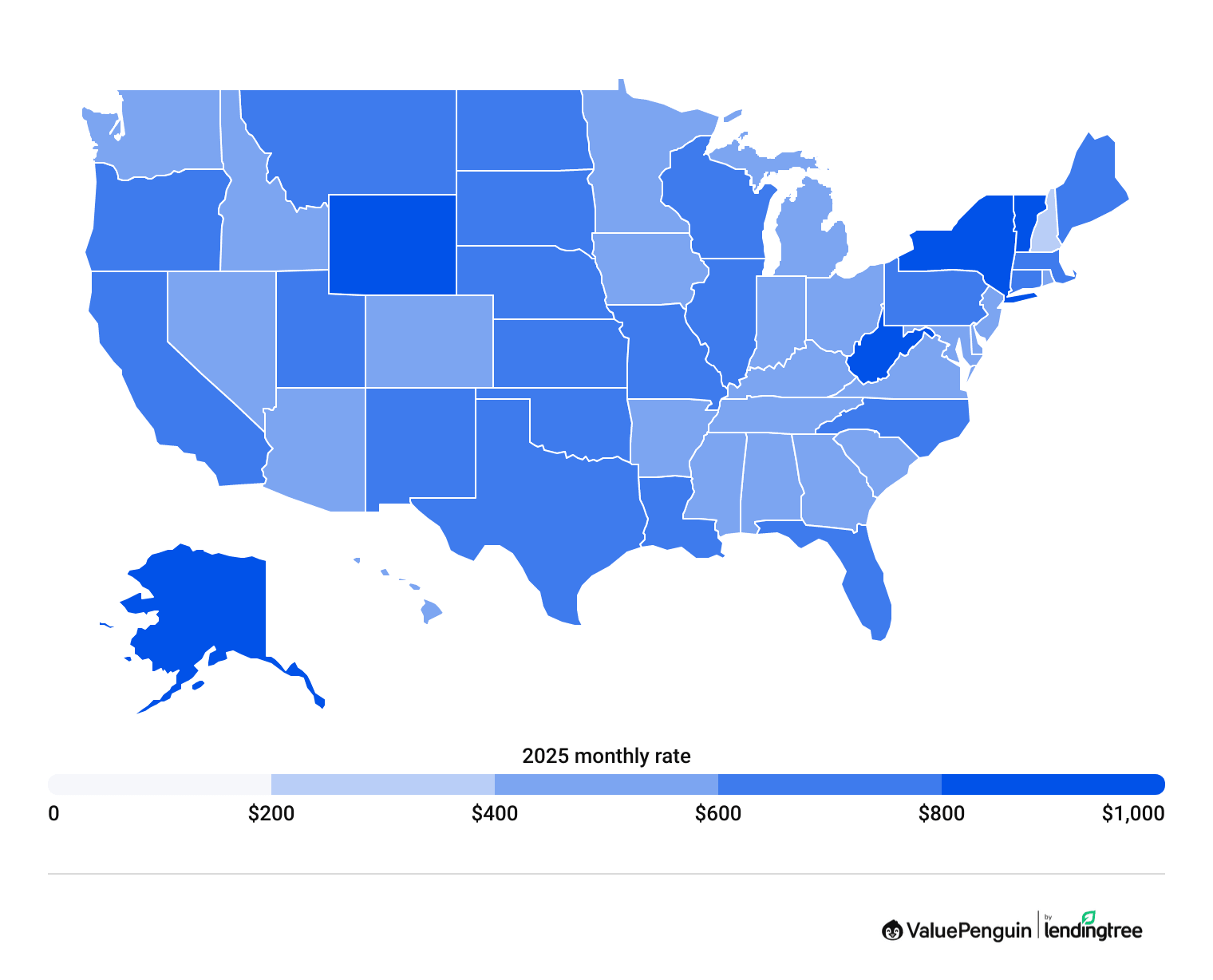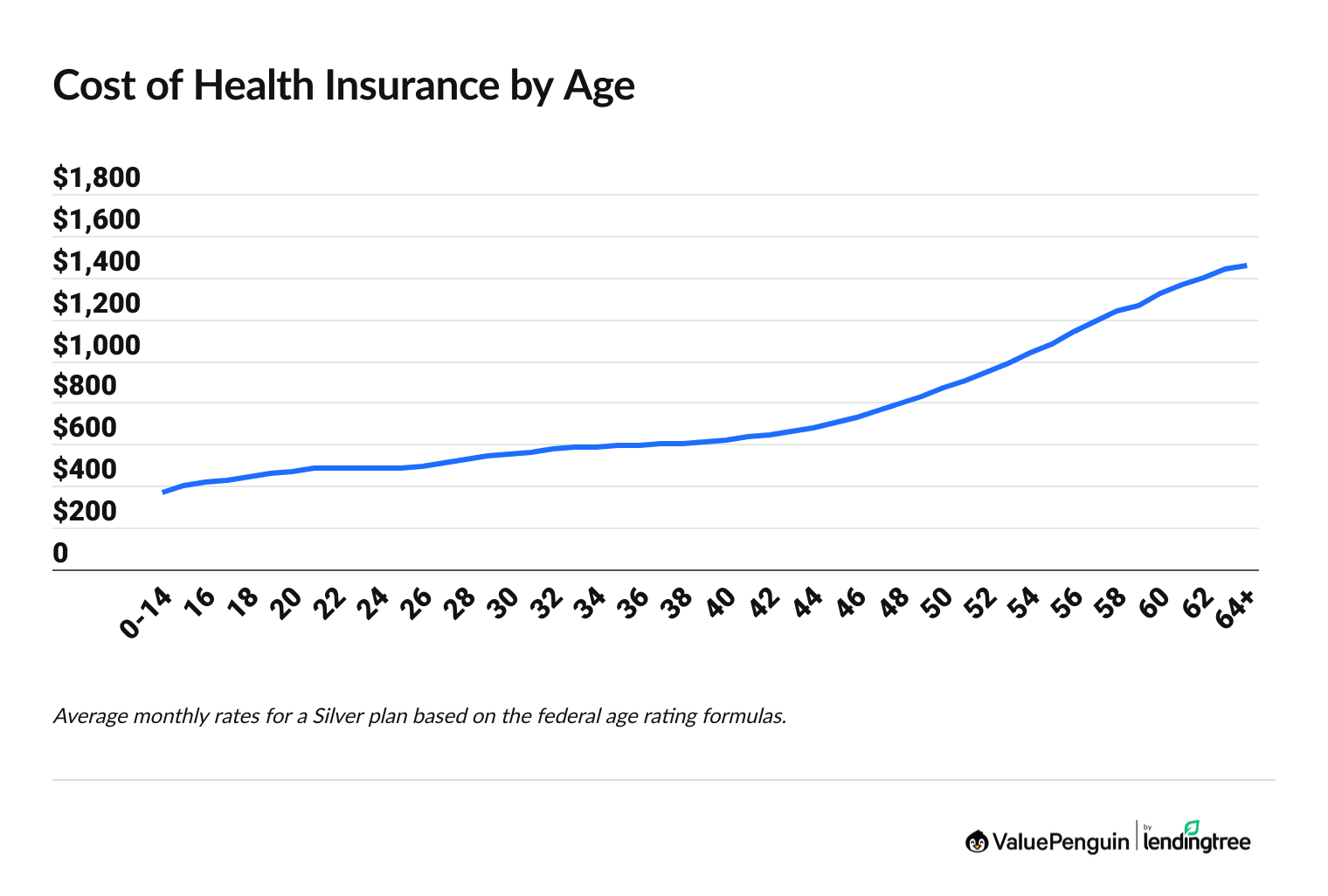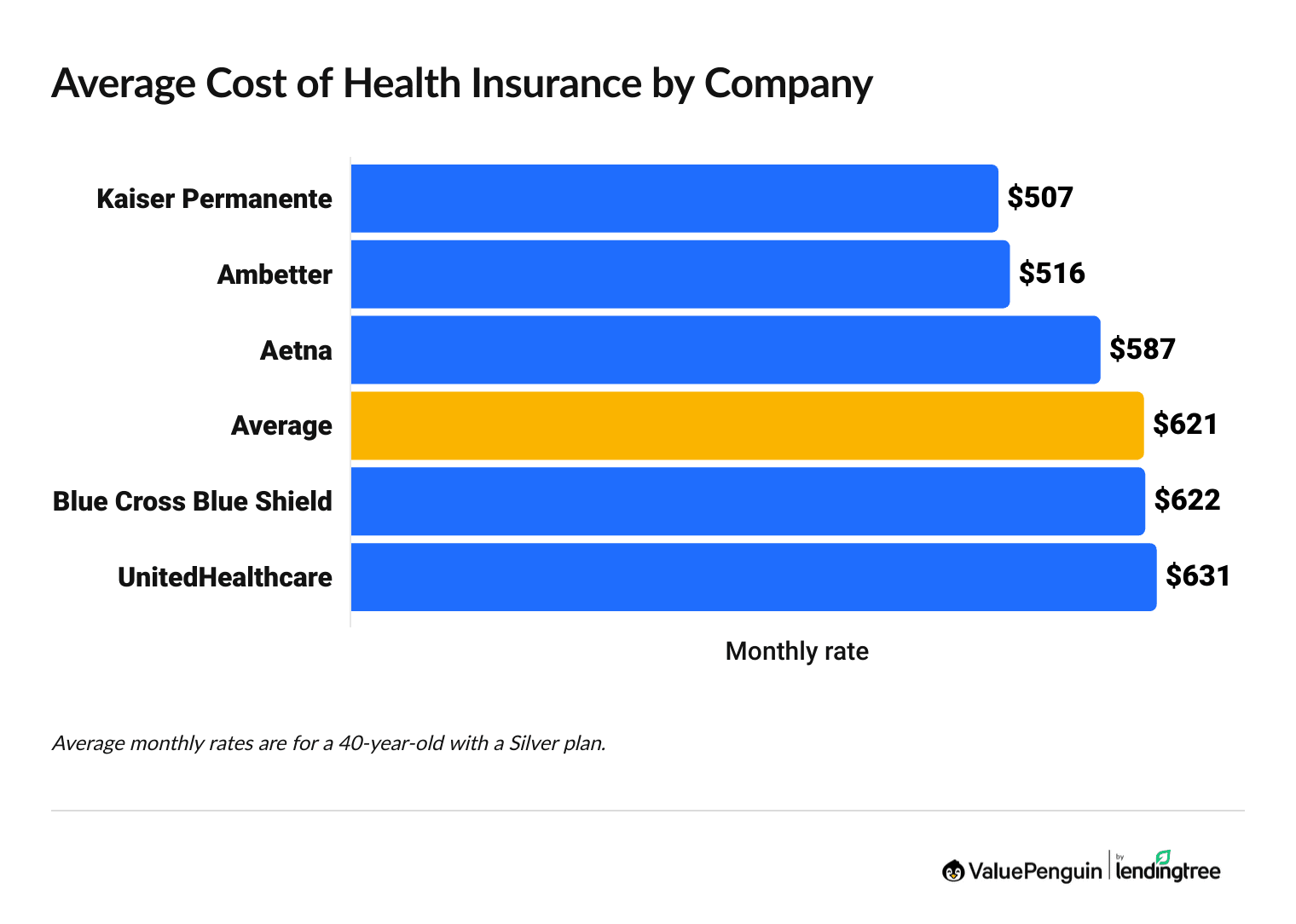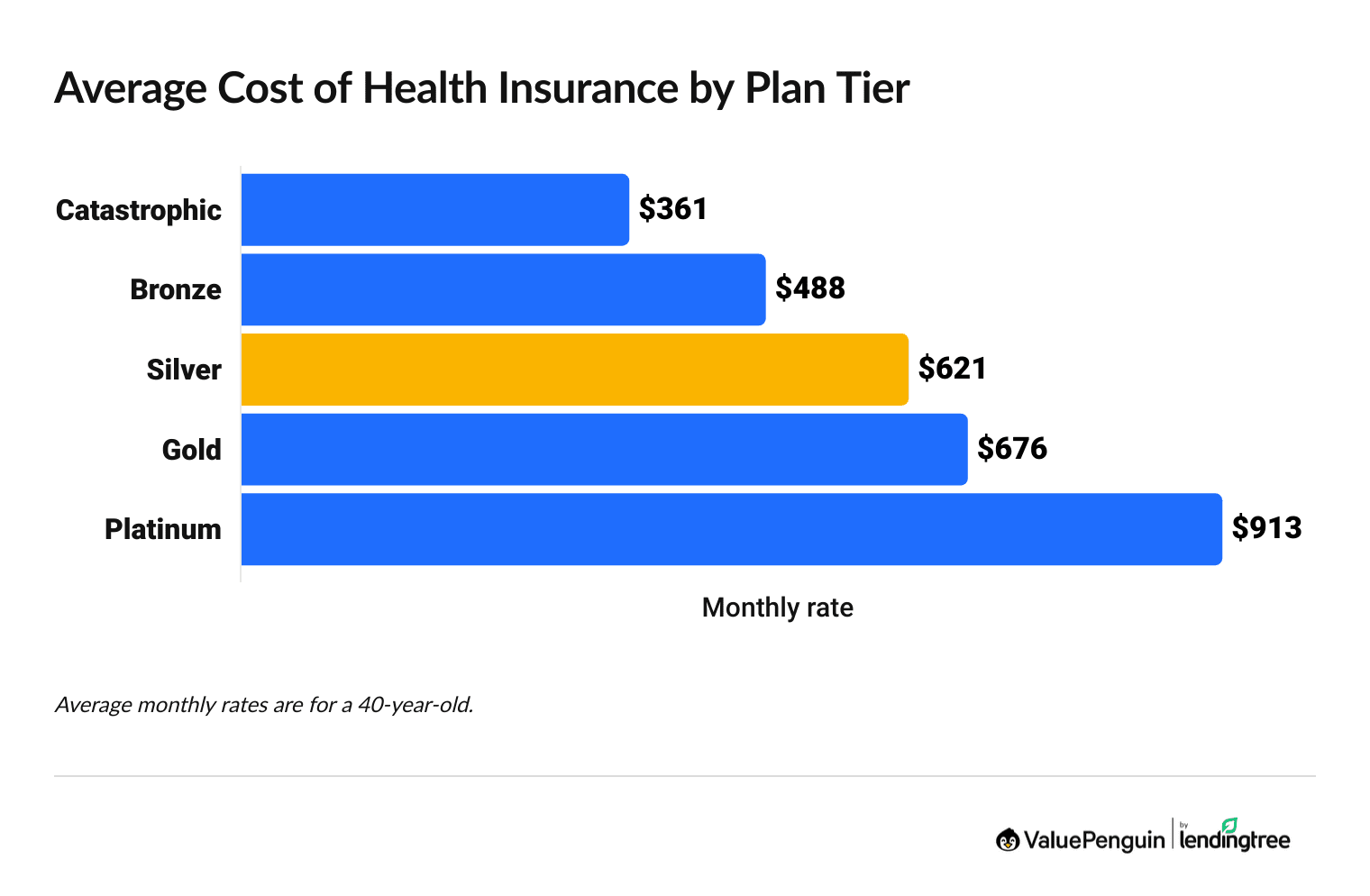Average Health Insurance Cost in 2025
A Silver health insurance plan from the ACA marketplace costs an average of $621 per month for 2025. That's 7% more than 2024.
Find Cheap Health Insurance Quotes in Your Area
How much does health insurance cost?
How much does health insurance cost per month for 2025?
For 2025, a Silver health plan costs $621 per month, on average, for a 40-year-old. Rates depend on things like your age, the plan tier you choose and where you live.
For example, people in West Virginia can pay $955 per month for a Silver plan, on average. In bordering Maryland, the same coverage costs an average of just $412 per month.
Most people who buy coverage from HealthCare.gov or a state marketplace don't pay the full monthly cost for health insurance. More than 90% of health insurance plans from HealthCare.gov or state marketplaces get discounts, called rate subsidies. These lower the amount you pay for health insurance each month. About four in five people can get health insurance for $10 or less per month.
How much is health insurance in my state?
Find Cheap Health Insurance Quotes in Your Area
How much did monthly health insurance costs change for 2025?
From 2024 to 2025, the average health insurance premium, or monthly rate, went up by 7% nationwide. Vermont saw the largest jump, at 27%.
Including Vermont, 42 states saw their average rates increase between 2024 and 2025.
Monthly health insurance costs dropped the most in Iowa and South Dakota, falling by 7% and 4%, respectively. Overall, six states had falling health insurance rates year on year, and in two states, the rates remained the same.
Why is the cost of health insurance going up?
Health insurance is getting more expensive, mostly because health care is getting more expensive.
The cost of medical care has more than doubled since 2000.
More expensive medical care means health insurance companies have to pay more when you see a doctor. Companies charge higher rates to cover the cost of your care.
How much does health insurance cost by age?
Health insurance costs more as you get older, with the most significant increases starting when you reach your late 40s. For example, the cost of health insurance nearly doubles between ages 40 and 55.
As you grow older, the likelihood of having health problems increases. This means you'll have to pay more for the same coverage.
Age doesn't affect your health insurance rates in New York or Vermont. And in seven states, age affects rates differently than it does in the rest of the country.
Health insurance cost by age
Age | 2024 cost | 2025 cost | % change |
|---|---|---|---|
| 0-14 | $349 | $372 | 7% |
| 15 | $380 | $405 | 7% |
| 16 | $392 | $417 | 7% |
| 17 | $404 | $430 | 7% |
| 18 | $416 | $444 | 7% |
Average monthly rate for a Silver plan. Percentages were calculated with rounded dollar amounts.
How much does health insurance cost from different companies?
Health insurance costs between $507 and $631 per month from the five biggest companies.
Most large companies offer some kind of low-cost medical insurance. Kaiser Permanente has the cheapest health insurance, while UnitedHealthcare (UHC) has the most expensive rates. But the average health insurance cost by state can differ to a wide degree, so UHC may be a good deal depending on where you live.
Find Cheap Health Insurance Quotes in Your Area
You might also find cheap health insurance from a smaller company, depending on where you live. The best way to find affordable health insurance plans is to compare quotes on your state's health exchange from different companies.
Average health insurance cost by company
Company | 2024 cost | 2025 cost | % change |
|---|---|---|---|
| Kaiser Permanente | $481 | $507 | 5% |
| Ambetter | $521 | $516 | -1% |
| Aetna | $502 | $587 | 17% |
| Blue Cross Blue Shield | $603 | $622 | 3% |
| UnitedHealthcare | $576 | $631 | 10% |
Average monthly cost for a 40-year-old with a Silver plan.
Average health insurance cost by plan tier
Health insurance rates range from $361 per month for a Catastrophic plan to $913 per month for a Platinum plan. Bronze plans, the best cheap health insurance for most people, cost $488 per month, on average.
Silver plans cost $621 per month on average. Over half of people who have ACA coverage choose Silver plans since they offer a good combination of moderate rates and middle-of-the-road costs that you're responsible for. Gold plans cost $676 per month, on average.
Silver plans are the middle tier, with average deductibles, copays and coinsurance.
Bronze vs Silver health insurance
Silver plans are the best choice for many people because of their middle-of-the-road costs. If you have a Silver plan and earn a low income, you may be able to get subsidies called cost-sharing reductions (CSRs). You can only get CSRs with Silver plans.
If you can't get cost-sharing reductions, a Bronze plan might make more sense for affordable medical insurance if you're in good health, and you can easily cover your plan's deductible from your savings.
Catastrophic and Bronze plans are the best options for cheap health insurance, but you'll have to pay more when you visit the doctor. These plans are best if you're young and healthy. Keep in mind, you can't get discounts, called subsidies, with a Catastrophic plan.
You're almost always better off with a Bronze or Silver plan if you qualify for subsidies.
Gold and Platinum plans are on the high end of coverage and price. These plans have high monthly rates, but you won't pay as much for medical care. Gold and Platinum plans may make sense if you have an ongoing condition that requires frequent trips to the hospital.
Monthly health insurance costs (2025) by tier
Tier | 2024 rate | 2025 rate | % change |
|---|---|---|---|
| Catastrophic | $335 | $361 | 8% |
| Bronze | $462 | $488 | 6% |
| Silver | $583 | $621 | 6% |
| Gold | $641 | $676 | 5% |
| Platinum | $811 | $913 | 13% |
Monthly rates are for 40-year-olds. The average for Bronze plans includes Expanded Bronze.
Average health insurance rates by plan type
Your monthly rate also depends on the plan type you choose. For example, PPOs (preferred provider organizations)tend to cost more than HMOs (health maintenance organizations). For a higher monthly rate, PPOs give you more flexibility when it comes to the doctors you see.
Find Cheap Health Insurance Quotes in Your Area
HMO health insurance plans tend to have cheap rates. But, you can't see doctors outside your network, and you need a referral to visit a specialist.
Monthly health insurance cost by plan type
Type | 2024 rate | 2025 rate | % change |
|---|---|---|---|
| HMO | $512 | $560 | 9% |
| EPO | $526 | $566 | 8% |
| PPO | $613 | $662 | 8% |
Monthly rates are for 40-year-olds. POS plans weren't included due to a lack of data across states.
Cost of private health insurance
Private health insurance through the Affordable Care Act (ACA) marketplace costs $621 per month for a 40-year-old with a Silver health plan, on average. What you pay for a private health insurance plan will depend on factors such as your age, plan tier, the type of insurance you choose and where you live.
Private health insurance includes plans you buy on your own, often called individual health plans, and plans through your workplace, sometimes called group health plans.
If you're not enrolling in a government-backed plan like Medicare or Medicaid, you're buying private health insurance.
Private health plans bought through a state or federal exchange are eligible for government subsidies(except Catastrophic plans). These subsidies can lower your monthly rate and, in some cases, help you pay for other insurance costs.
Nineteen states and Washington, D.C., run their own health insurance marketplaces. If you don't have access to a state-run health exchange, you can buy a private health insurance plan through HealthCare.gov.
States with health marketplaces
- California
- Colorado
- Connecticut
- Georgia
- Idaho
- Kentucky
- Maine
- Maryland
- Massachusetts
- Minnesota
- Nevada
- New Jersey
- New Mexico
- New York
- Pennsylvania
- Rhode Island
- Vermont
- Virginia
- Washington
- Washington, D.C.
You can also buy private health insurance directly from an insurance company, through an agent or from a broker. These plans are sometimes called "off-exchange" policies and might include ACA plans.
Off-exchange plans don't qualify for cost-saving subsidies. Before you buy, it's a good idea to compare on- and off-exchange plans to see which can save you more money.
Factors that impact health insurance rates
- Age: Generally speaking, your health insurance rates will increase as you get older until you reach age 65 and become eligible for Medicare.
- Where you live: Your rate also depends on the state and county you live in. For example, health insurance costs more than twice as much in Alaska compared to Indiana, on average.
- Smoking/tobacco use: Smokers may pay up to 50% more than nonsmokers in some states.
- Number of people covered: Health insurance costs increase as you add more people to your plan. For example, a family of three will pay more for coverage than a single person.
Your insurance company, your plan tier and whether you have an HMO or a PPOalso impact your monthly rate.
Frequently asked questions
For 2025, the average cost of health insurance is $621 per month for a Silver plan. Remember, the cost you pay will depend on where you live, your age, plan tier and other factors.
The average cost of health insurance increased by 7% between 2024 and 2025.
Private health insurance is any type of medical insurance sold by a company. This includes workplace coverage — often called group health insurance — and individual coverage.
Government health insurance plans like Medicare and Medicaid aren't considered private health insurance.
A Silver health insurance plan costs an average of $621 per month on the health insurance marketplace. People making a low income may qualify for subsidies, which can drastically lower your monthly costs. If you earn $30,000 a year, a Silver plan could cost $49 per month. If you earn $45,000, you could pay $223 per month for coverage, on average.
Private health insurance for 2025 costs an average of $621 per month if you pay full price on the ACA marketplace.
If you get health insurance through your job, you'll pay an average of $114 per month. Your employer will pay the remaining $632 per month for your coverage.
Methodology
Health insurance rates and plans are taken from public use files (PUFs) on the Centers for Medicare & Medicaid Services (CMS) government website. Separately, data came from the websites of state-run marketplaces that don't use the federal marketplace.
Using the rates for each plan, ValuePenguin determined averages for different variables. Average costs per state are for Silver plans for 40-year-olds. Rates for Catastrophic plans and different plan types are based on the data that's available and don't include all states.
Info about health and aging is from the World Health Organization (WHO). ValuePenguin determined the rates for various ages based on the rating guidelines from CMS.
Research on rising health insurance costs comes from the Peterson-KFF Health System Tracker report on medical inflation.
The cost of health insurance for employees is from KFF's employer benefits survey.
Editorial note: The content of this article is based on the author's opinions and recommendations alone. It has not been previewed, commissioned or otherwise endorsed by any of our network partners.





